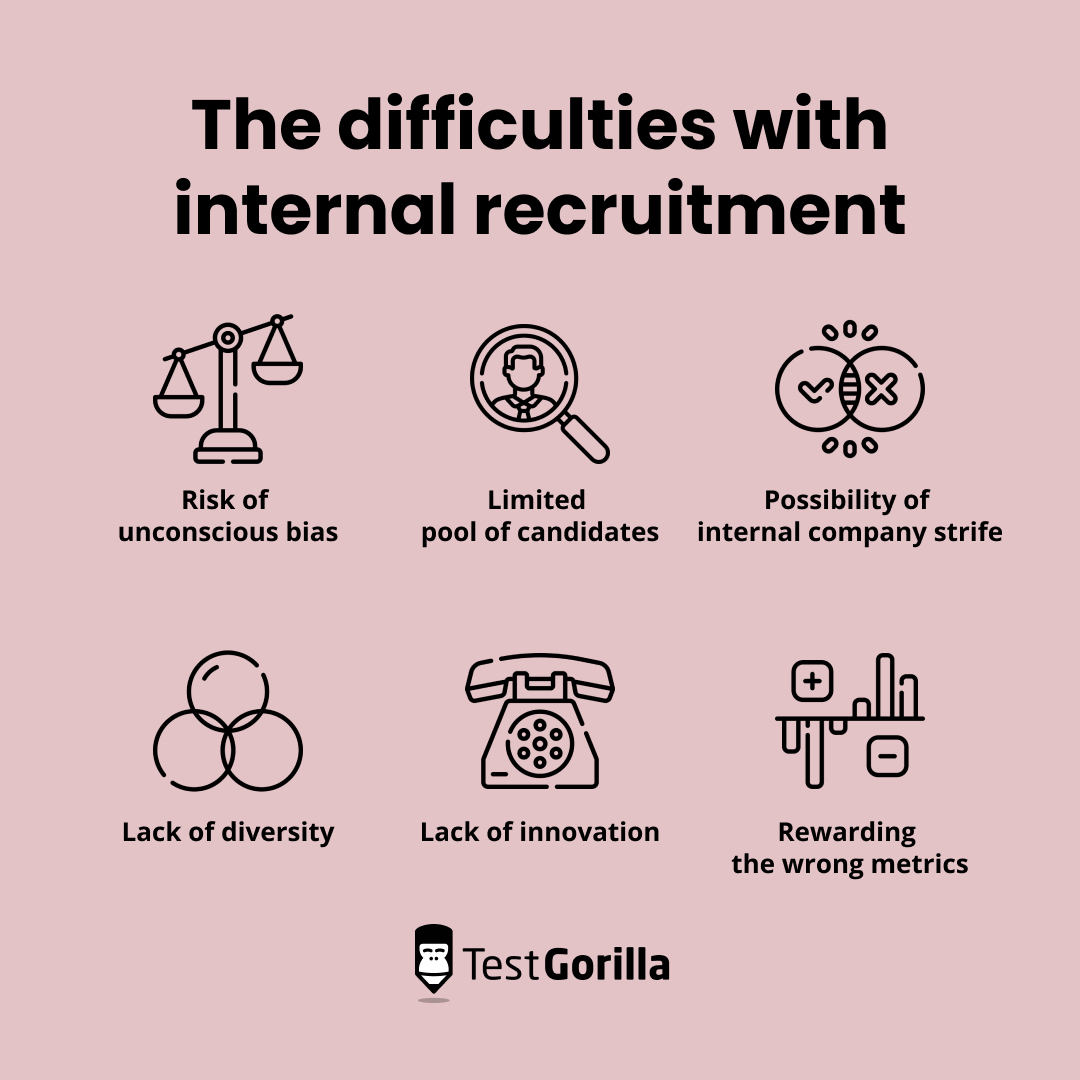Internal recruitment: How talent assessments help you ace hiring from within
Traditional hiring methods that have been relied upon for decades are facing challenges and limitations.
Everywhere you look, businesses are struggling to attract and retain talent at an unprecedented scale. This desperation leads to many companies making bad hires, forcing them in a vicious, time-consuming cycle of hiring and rehiring.
And, with a bad hire costing up to 200% of an employee’s yearly wages, traditional hiring methods are become a real gamble.[1]
But think about this:
That difficult-to-find, highly motivated candidate may be closer than you think – they could even be in your organization already.
So what’s the best way to identify that candidate? Use skills-based hiring practices.
Internal recruitment, fused with talent assessments, helps your business get it right when filling an open role.
If you want to read about the ins and outs of internal recruiting, you’re in the right place.
Table of contents
- What is internal recruitment?
- The difficulties with internal recruitment
- How talent assessments help with internal recruiting
- 7 ways to use talent assessments to optimize internal recruiting
- Beyond talent assessments: 4 best practices to remember for internal recruitment
- Leverage talent assessments in your internal recruitment strategy
What is internal recruitment?
Internal recruitment is the process of looking inwards and redeploying an already existing employee to fill an open role in an organization. This role could be a new opening or one that requires backfilling.
This form of recruitment usually involves posting the position using company-wide mediums – such as intranet, email, internal job boards, and newsletters – and selecting the best candidate from the internal talent marketplace.
Internal vs. external recruitment
External recruitment involves hiring people who are outside the organization. Typically, human resources managers develop a job description, post it on job boards, and select the new hire from a pool of applicants.
In some instances, external recruitment involves headhunting – hiring managers and recruiters reaching out directly to people they believe are qualified for a particular role.
Ideally, internal and external hiring should mirror each other in terms of job description, candidate selection, and onboarding.
A key difference between the two is the size of the talent pool, with external candidates offering you a much broader range of choices. However, internal recruitment has its own indispensable benefits that make it a valuable option, as we cover later on.
You can always use internal recruiting as a starting point to identify high-quality candidates, and then look externally if you don’t find the right fit internally.
Types of internal recruitment
There are different internal recruitment methods you can use to find suitable candidates inside your organization.
Here are some common types you need to know about:
Promotion: advancing an outstanding employee to a new, higher position
Part-time to full-time transition: hiring a previously contracted or seasonal employee on a full-time arrangement
Transfer: moving an employee from one location or department to another
Upskilling: assigning new responsibilities to an employee who has improved their skill set
Horizontal: shifting an employee’s roles within departments, functions, or industries
Lateral: moving an employee across roles but within the same function
Confirmation: hiring a contractor, an intern, or an apprentice from a temporary to a permanent role
Advantages of internal recruitment
Internal recruiting is often overlooked despite being a time and money saver and a source of top talent.
There’s one more thing – internal hiring shows your existing workforce that you care about their career advancement.
With a Gartner survey indicating that fewer than one in three employees knows how to progress their career over the next five years, internal recruiting might be the answer to your employees’ career growth question.
Here are the proven benefits of internal recruitment:
Reduce hiring cost: Recruiting is a huge cost, and justifying this cost can be a headache for HR leaders. Getting internal talent improves your hiring efficiency and saves slack.
Improved employee engagement: Finding talent from within is a surefire way of showing your employees that their skills and performance matter. Rewarding your talent is not just about money; it is also about the intrinsic motivation employees feel when you show you value them.
Less time to hire: The longer it takes to fill an open role, the more your business faces uncertainty. You can reduce your time to hire by looking for skilled top performers already located within your ranks.
Less intense onboarding: Onboarding is an essential activity for all types of hires, internal or external. However, internal hires require less rigorous onboarding and training since they are familiar with the company's culture, work flows and mission.
Meet diversity, equity and inclusion metrics with internal hiring: If you already have a diverse workforce, internal recruiting can help you supercharge diversity hiring; for instance, by promoting historically marginalized people or women to higher ranks.
Career pathing: A career path is a plan that describes the steps an employee must take to build the professional skills they need to reach a long-term goal. Internal recruitment opens up multiple career pathways for your current workforce.
The difficulties with internal recruitment
Traditional recruiting methods don’t just fall short in external recruitment; they pose significant difficulties when applied to internal recruiting, as well.
For instance, these methods' overreliance on credentials often exclude skilled employees who have no formal education.
As job roles and industries evolve, traditional methods don’t capture the skills and qualities needed for emerging internal roles.
Here are six clear disadvantages of internal recruitment using traditional methods.
Risk of unconscious bias
Traditional methods often involve human judgment and decision-making, which can be influenced by unconscious biases.
This goes doubly for internal recruitment because you may be interviewing colleagues you already know or even close friends. This can make it extra difficult to separate your personal feelings from the hiring process.
Again, inherent biases might lead recruiters to favor candidates from certain backgrounds or demographics, excluding potentially qualified candidates from underrepresented groups.
Limited pool of candidates
Traditional methods prioritize specific skills or qualifications that can be easily evaluated on a resume or in a short interview.
Because of this, skilled candidates with no formal education or credentials may miss out on internal mobility opportunities.
Overlooking candidates with unique or non-traditional backgrounds leads to a limited talent pool, denying your company valuable perspectives and skills.
Possibility of internal company strife
When multiple internal candidates compete for the same role, it can lead to feelings of resentment and workplace conflicts.
Employees might feel the company is not recognizing their skills and contributions.
Moreover, if the hiring process appears biased rather than merit-based, it can create a perception of favoritism, erode trust, and affect employee morale.
In some cases, employees who are not selected for internal opportunities might choose to leave the organization in search of better prospects elsewhere.
This can result in the loss of valuable talent.
Lack of diversity
When an organization's current workforce lacks diversity, using traditional methods in internal recruiting does little to combat the existing homogeneity.
If certain groups of employees have historically been excluded from certain roles or career paths within the organization, these methods can inadvertently perpetuate these gaps by keeping them from accessing new opportunities.
For instance, if your company is male-dominated, using traditional methods may not give women a chance to break into higher roles.
Lack of innovation
Traditional methods of internal recruiting rely on established criteria and job descriptions.
Although these are beneficial in some cases, they also lead to a preference for candidates who are less likely to disrupt the status quo, thereby hindering innovative approaches.
In addition, traditional methods might cause decision-makers to lean toward internal candidates they are already familiar with.
This may lead to a confirmation bias where you favor candidates who conform to existing practices, stifling introduction of fresh ideas.
Rewarding the wrong metrics
Traditional methods often focus on specific skill metrics that are easy to measure, such as length of service to the company.
Although tenure can indicate loyalty and familiarity with the organization, it doesn't necessarily reflect an employee's performance, potential, or suitability for a new role.
For instance, these metrics might not capture the full range of skills and qualities needed for a new role, leading to internal mobility based on incomplete information.
The end result? Promotion of individuals who might not have the skills or capabilities required for the position.
How talent assessments help with internal recruiting
Talent assessments serve as a strategic compass in internal recruiting, guiding companies to identify, nurture, and deploy their existing talent.
Here’s how talent assessments help you turn your internal recruiting efforts into a company-wide:
Identify skills gaps
Talent assessments help HR and hiring managers perform a skills gap analysis for employees.
Incorporating talent assessments into your internal recruitment process ensures that you have a clear understanding of the skills your employees possess and the areas that need improvement.
This approach contributes to the overall success of the organization by aligning talent acquisition with company strategic goals.
Inform professional development opportunities
When you identify skills gaps in your existing, you don’t stop there – you go ahead and find ways of ensuring your employees have the skills to meet new challenges.
Talent assessments give you an overview of the areas where employees have potential but might require further personal professional development.
Based on the assessment results, you can create personalized development plans for employees, outlining the specific new skills they need to bridge the gap and succeed in the desired role.
In essence, talent assessment improves the effectiveness of your employee training and development efforts.
Enhance objective evaluation of employee skills
Having the right talent assessment framework enables you to evaluate employees across different teams and departments. This helps ensure a fair selection process, avoiding biases that might arise in hiring decisions. Using the right skills tests and internal interview questions is essential.
Enable transparent and data-driven hiring process
Talent assessments also generate quantitative data that help you justify decisions such as employee promotions, benefits packages, and reskilling.
This type of data-driven approach reduces reliance on subjective judgments and helps make more informed decisions.
A transparent, merit-based hiring process fosters employee trust and contributes to a positive employee experience.
Promote internal mobility
Talent assessments assist in identifying employees with high potential and transferable skills who may be suitable for different roles within the organization.
When you demonstrate commitment to internal mobility, you inevitably enable your employees to grow their careers within the company, reducing turnover and enhancing employee loyalty.
An SHRM study found that 77% of employees who left jobs could have been retained, with a significant percentage citing lack of career advancement as the reason for leaving.[2]
When you’re able to retain your best talent through internal career development, your organization can comfortably watch the talent war from outside the ring.
Expand the talent pool and getting diversity right
Internal recruitment sometimes leads to a limited pool of candidates, particularly if certain departments or teams lack diversity.
With talent assessments, you can identify promising candidates from underrepresented groups within the organization, thereby attracting more job applicants and increasing the chances of promoting diversity.
Supercharge succession planning
Succession planning involves reducing the risk of leadership gaps due to retirements, resignations, or unexpected departures.
Talent assessments help mitigate this risk by identifying multiple potential successors for critical roles, reducing the impact of such transitions.
Talent assessments can help identify employees who exhibit leadership qualities with the potential to take on higher-level responsibilities and ensure a robust leadership pipeline.
You can also create personalized leadership development plans for high-potential employees to address specific areas for improvement, ensuring that candidates are adequately prepared for the demands of the targeted roles.
7 ways to use talent assessments to optimize internal recruiting
In internal recruiting, talent assessments help companies get a better understanding of the people they currently work with.
Here are seven ways how talent assessments optimize your internal recruitment process.
How to optimize internal recruitment with talent assessments: A summary
Optimization method | Description |
1. Create a quick-access skills database | Create a robust skills' database, describing each employee's abilities and potential, so you can easily identify suitable candidates for future openings |
2. Remove unconscious bias from your recruitment process | Standardize the evaluation process to ensure each candidate is judged on the same parameters |
3. Develop internal talent pool | Leverage talent assessment to develop employee training and development plans to help employees enhance their skills |
4. Facilitate career pathing | Use talent assessments to help employees understand the various career paths available within the organization |
4. Track employee performance and growth | Analyze talent assessments data to measure the effectiveness of learning and development programs |
5. Promote talent sharing | Identify employees' transferable skills and match them with suitable opportunities in other areas of the organization |
6. Use talent assessments to identify candidates from other departments or partner companies | Look for candidates with different backgrounds and skills to promote cross-pollination of ideas and increase innovation |
1. Create a quick-access skills database
Regularly conducting talent assessments for all employees provides you insights into their individual skill sets.
This data can then be compiled to create a robust skills' database, documenting each employee's abilities and potential.
With this type of effective talent pool management, you can easily identify suitable candidates for future openings to streamline the hiring process.
SiddhiSai Web Solutions, a software development company, was looking to speed up the hiring process and make it more objective and data-driven.
SiddhiSai’s hiring process involved administering manual tests, which weren’t sufficiently reliable and resulted in bad hires.
The company needed a comprehensive and easy-to-use testing platform that would administer skills tests quickly and efficiently and provide unbiased and reliable results.
TestGorilla enabled SiddhiSai Web Solutions to:
Optimize and expedite the hiring process
Accurately assess candidates’ technical skills
Avoid mis-hires
2. Remove unconscious bias from your recruitment process
Unconscious bias in hiring can inadvertently influence hiring decision-making.
Talent assessments mitigate this bias by focusing on objective, job-related criteria rather than personal attributes.
These assessments standardize the evaluation process, ensuring each candidate is judged on the same parameters.
This fosters a more diverse and inclusive workforce, and leads to better hiring choices more closely aligned with organizational goals.
Capital T, a seed-stage venture capital fund, was looking for a hiring platform that could increase the diversity of shortlisted candidates.
With hundreds of candidates applying for job openings, it was impossible to scan through every resume.
Using the TestGorilla platform and tests such as the Critical Thinking test, Capital T was able to shortlist candidates without having to review their resumes.
The platform also led to a diverse candidate pool, and, in the end, the fund hired two diverse candidates.
3. Develop internal talent pool
The talent development process is excellent for sourcing new employees, but it can also gauge the potential of current employees.
Talent assessments assist in building employee training and development plans to help employees enhance their skills.
For instance, when hiring for customer-facing roles, the HubSpot CRM test can help you identify candidates who can effectively use the full suite of HubSpot tools.
You can then develop targeted training to improve your employee's skill set and further prepare them for future roles, enhancing employee satisfaction and retention efforts.
4. Facilitate career pathing
Talent assessments also help your team members understand the various career paths available within the organization.
This clarity encourages employees to work towards specific goals and increases their motivation to excel.
For instance, a cybersecurity professional who wants to pivot to Android app development can do so without leaving the company.
Career pathing doesn’t just benefit your employees – the company reaps its fair share of rewards, too.
According to a McKinsey study, creating skills-based pathways for your employees makes companies more resilient during periods of economic downturns by enhancing adaptability.
Mapping out roles based on skills rather than traditional job titles enables easier redeployment to areas of higher demand, reducing layoffs.
5. Track performance and growth
Performance management is a critical component of workforce management. You want to know which employees are meeting set targets most efficiently.
Most importantly, you want to get to the bottom of why an employee is underperforming.
Talent assessments generate data, which can be invaluable in measuring the effectiveness of learning and development programs.
You can even apply this data to predict job performance.
Take the case of 7Systems, a software development company whose main hiring pain point was its inability to assess candidates’ technical competence levels.
Using TestGorilla’s assessments, the company was able to get a detailed understanding of candidates’ skills and knowledge, enabling the right hiring decisions.
The assessments also helped the company predict job performance more accurately, since candidates who did well on the tests were also successful in their roles.
6. Promote talent sharing
Talent sharing refers to the strategic movement of employees across teams, departments, or locations to meet business hiring needs and optimize workforce utilization.
Rather than view talent as a scarce resource, talent sharing promotes talent abundance – and that needs to be shared across teams and the entire company.
Talent sharing provides employees with fresh challenges and growth opportunities. It helps retain top performers who might seek external opportunities if their growth stagnates within their current roles.
Talent assessments can play a pivotal role in enhancing talent sharing within an organization.
For instance, talent assessments help identify employees' transferable skills, making it easier to match them with suitable opportunities in other areas of the organization.
A stellar example of talent sharing is Unilever, whose Flex Experiences internal talent marketplace is used by 65,000 workers.
During the pandemic, the company was able to redeploy more than 3000 employees to higher demand areas of the business, maximizing productivity.
7. Use talent assessments to identify candidates from other departments or partner companies
Skills tests and skills-based hiring can be used to identify internal candidates from different departments or roles who might not have been considered for the new position using traditional recruiting methods.
Instead of limiting hiring decisions to traditional vertical promotions within a specific department, you can consider lateral moves or hires from other departments or functional areas.
You might even enter into strategic partnerships with other companies to tap into existing talent pools, like Siemens and Disney did.
When Siemens developed a hearing device for kids, the company reached out to Disney to leverage on the latter’s expertise in marketing to families and children.[3]
Such cross-pollination of ideas enhances collaboration and knowledge sharing, leading to increased innovation.
Beyond talent assessments: 4 best practices to remember for internal recruitment
Implementing effective internal hiring practices enhances employee engagement, encourages professional growth, and empowers you to tap into the existing talent within your organization.
Here are four best practices to supercharge your internal hiring:
1. Define internal recruitment process and policy
As with any other critical organizational process, you need to document the internal recruitment policy.
A well-laid hiring policy enhances transparency by eliminating gray areas that may impede the success of the internal hiring process.
Key clauses you can have in the policy include:
How to identify open positions
Job posting and communication
Application process
The selection process and criteria
Training and development needs
Equal opportunity and non-discrimination
Once you develop a policy, circulate the document across departments to keep your employees well-informed of its content.
2. Communicate, communicate, communicate!
Communicating every step of the internal hiring process cannot be overemphasized.
Since you are tapping into your existing employees, keeping them in the loop enhances employer-employee trust.
The reverse is also true: If employees learn of internal vacancies when they have already been filled, it's likely to cause negative vibes.
Here are critical junctures where communication can make or break the process:
Crafting the job description: When developing the job description, ensure it's clear so all eligible and interested employees can apply.
During the hiring process: Clarify the hiring process from start to finish, such as how and where to apply, and the criteria you use to select successful candidates.
Giving feedback to candidates: Provide timely feedback to every applicant. Have a candid conversation with unsuccessful applicants to discuss areas for improvement.
Communicating the hiring decision: Publicly announce the successful candidate to provide an extra layer of transparency to the entire process.
3. Be realistic about the candidate pool
Although internal recruitment is an excellent, low-cost solution for when you need to fill a role, it’s important to understand that it doesn’t always yield the ideal candidate because of your limited internal talent pool.
The skills you need may not be available, or your employees might simply not be interested in the opportunity.
In that case, have a proactive plan to get your desired hire from other talent pools, such as recruiting from outside the organization, head-hunting, or rehiring an ex-employee.
4. Don't skip onboarding
It might be tempting to overlook onboarding since these employees are already familiar with company processes and culture.
Don’t fall for this trap.
Onboarding is not just about introducing new employees to the organization; it's also about helping existing employees transition smoothly into new roles.
Effective onboarding supports the psychological and emotional aspects of this transition, helping employees feel more confident in their new roles.
Leverage talent assessments in your internal recruitment strategy
Looking internally for existing talent is a strategic mindset shift that can help your organization fill open roles fast, cost-effectively, and with precision.
Incorporating talent assessment into your internal recruitment efforts takes the game a notch higher.
Talent assessments help you establish which employee has the skills for a particular role, saving you the costs and hassle of dipping into the job market.
What’s more, they enable you to identify existing skills gaps and overlaps, insights that can be invaluable in developing training programs to help employees progress internally.
To keep learning, check out our article on how to improve your recruitment and selection process.
Sources
McFeely, Shane; Wigert, Ben. (2019). “This Fixable Problem Costs U.S. Businesses $1 Trillion”. Gallup. Retrieved August 22, 2023. https://www.gallup.com/workplace/247391/fixable-problem-costs-businesses-trillion.aspx
Tarallo, Mark. (2018). “How to reduce employee turnover through robust retention strategies”. SHRM. Retrieved August 22, 2023. https://www.shrm.org/resourcesandtools/hr-topics/talent-acquisition/pages/how-to-reduce-employee-turnover-through-robust-retention-strategies.aspx
Sylt, Christian. (August 29, 2014). “Why Siemens And Disney Make A Magical Team”. Forbes. Retrieved August 28, 2023. https://www.forbes.com/sites/csylt/2014/08/29/why-siemens-and-disney-make-a-magical-team
Related posts
You've scrolled this far
Why not try TestGorilla for free, and see what happens when you put skills first.
Latest posts
The best insights on HR and recruitment, delivered to your inbox.
Biweekly updates. No spam. Unsubscribe any time.

Skills tests to hire the best
Our screening tests identify the best candidates and make your hiring decisions faster, easier, and bias-free.
Free resources
A step-by-step blueprint that will help you maximize the benefits of skills-based hiring from faster time-to-hire to improved employee retention.
With our onboarding email templates, you'll reduce first-day jitters, boost confidence, and create a seamless experience for your new hires.
This handbook provides actionable insights, use cases, data, and tools to help you implement skills-based hiring for optimal success
A comprehensive guide packed with detailed strategies, timelines, and best practices — to help you build a seamless onboarding plan.
This in-depth guide includes tools, metrics, and a step-by-step plan for tracking and boosting your recruitment ROI.
Get all the essentials of HR in one place! This cheat sheet covers KPIs, roles, talent acquisition, compliance, performance management, and more to boost your HR expertise.
Onboarding employees can be a challenge. This checklist provides detailed best practices broken down by days, weeks, and months after joining.
Track all the critical calculations that contribute to your recruitment process and find out how to optimize them with this cheat sheet.
















